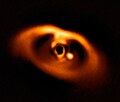This article needs additional citations for verification .(November 2024) |
Type of site | Astronomy |
|---|---|
| Created by | Operated for NASA by JPL/Caltech |
| URL | http://nsted.ipac.caltech.edu |
| Current status | Closed |
The NASA Star and Exoplanet Database (NStED) was an on-line astronomical stellar and exoplanet catalog and data service that collated and cross-correlated astronomical data and information on exoplanets and their host stars. NStED was dedicated to collecting and serving important public data sets involved in the search for and characterization of exoplanets and their host stars. [1] The data included stellar parameters (such as positions, magnitudes, and temperatures), exoplanet parameters (such as masses and orbital parameters) and discovery/characterization data (such as published radial velocity curves, photometric light curves, images, and spectra).
Contents
The NStED collected and served public data to support the search for and characterization of extra-solar planets (exoplanets) and their host stars. The data included published light curves, images, spectra and parameters, and time-series data from surveys that aim to discover transiting exoplanets. All data were validated by the NStED science staff and traced to their sources. NStED was the U.S. data portal for the CoRoT mission.
As of June 2007, the database catalogued 140,230 stars, [1] but by December 2011, NStED was discontinued, with most data and services transferred to the NASA Exoplanet Archive. [2]
